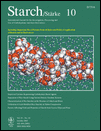Physical Basis for Separation of Rice Starch using Various Density Gradient Systems and its Effect on Starch Recovery, Purity, and Pasting Properties
Abstract
A 32% waxy and non waxy rice flour slurry containing starch-protein agglomerates was physically disrupted in presence of water by use of high pressure homogenizer called Microfluidizer®. Microfluidized rice flour slurry from passes 2 and 4 was collected followed by isolation of starch using three different density gradient solutions/systems (CeCl, NaCl/sucrose and ZnSO4·7H2 O). Complete deagglomeration was obtained after passing the rice flour slurry four times through the Microfluidizer®. The recovery of isolated starch varied from 76.28% to 91.20% for different density gradient systems. The degree of deagglomeration did not seem to affect recovery but affected the purity of the isolated starches. All starches produced from pass 4 rice slurry resulted in starches with residual protein below 0.5%. Higher density of the gradient solution resulted in higher recovery and purity of starch. The isolation method had a significant effect on the pasting properties of the isolated starch. Residual protein in isolated starch had a negative correlation with peak viscosity and setback of pass 2 waxy and nonwaxy starches. The salts were retained in purified starch despite rigorous washing (at least 75 times greater than the control) and could affect starch properties.




